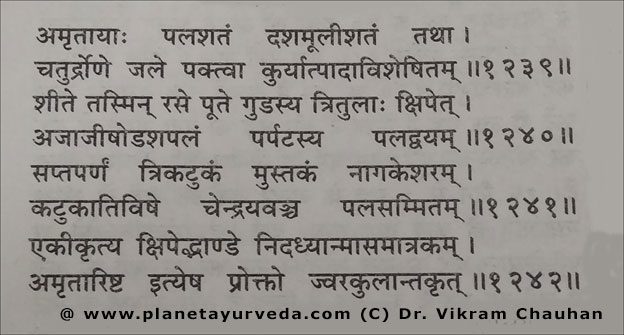AMRUTHARISHTAM – INGREDIENTS, INDICATIONS, USES AND BENEFITS
INTRODUCTION
It is a classical ayurvedic formulation, which is mainly used in the treatment of fever. It is named amrutharishtam as the main active ingredient of this formulation is amrita (guduchi) which is a potent antipyretic agent.
INGREDIENTS
- Guduchi kaand (Tinospora cordifolia) – 4.700 kg
- Dashmool yavkuta – 4.700 kg
- Water – 50 litres
- Guda (jaggery) – 14.100 kg
- Jeera (Cuminum cyminum) – 750 gm
- Parpat (Fumaria vaillantii) – 90 gm
- Saptaparani (Alstonia scholaris) – 46 gm
- Shunthi (Zingiber officinale) – 46 gm
- Pippali (Piper longum) – 46 gm
- Marich (Piper nigrum) – 46 gm
- Nagarmotha (Cyperus rotundus) – 46 gm
- Naagkesar (Mesua ferrea) – 46 gm
- Katuki (Picrorhiza kurroa) – 46 gm
- Aatees (Aconitum heterophyllum) – 46 gm
- Indrayav (Holarrhena antidysentrica) – 46 gm
- Dhataki pushpa (Woodfordia fruticosa) – 500 gm

REFERENCE: – Bhaishajya ratnavali // jwaradhikar (5/ 1239-1242)
BENEFITS OF INGREDIENTS
- AMRITA:- It is a herb which pacifies all three doshas. It acts as antipyretic, analgesic, antiemetic, digestant, antiparasitic, haematinic, blood purifier and anti-oxidant.
- DASHMOOL:- Dashmool is used in the treatment and prevention of various health problems such as neurological issues, lower back pain, lung disorders, etc. It acts as antipyretic, anti-oxidant, anti-rheumatic, analgesic and sedative.
- JEERA:- It is ushna (warm) potency that pacifies kapha and vata dosha. It helps in the treatment of various types of acute and chronic fevers, and digestive problems.
- PARPAT:- It is a herb which is mainly used in the treatment of the kapha and pitta originated diseases such as fever, vertigo, bleeding disorders, rheumatoid arthritis, gout, skin diseases, etc.
- SAPTAPARANI:- It is a herb having bitter and astringent properties due to which it pacifies kapha and pitta dosha. It is mainly used in the treatment of chronic fever (such as malaria and typhoid), liver disorders, diabetes, skin disorders, cardiac problems, etc.
- MARICH:- It is a herb which is an ingredient of trikatu, it has properties of pacifying vata and kapha dosha. It is mainly used as antipyretic agent in treating chronic fever, influenza, also acts as carminative, appetizer, ant parasitic, etc.
- SHUNTHI:- It is a herb which pacifies kapha and vata dosha due to its properties. It acts as anti-inflammatory, analgesic, digestive, antipyretic, cough suppressant, etc.
- PEPPER:- It is a herb used as a potent cough suppressant. It is also used in the treatment and prevention of chronic fever, cough, cold, indigestion, skin disorders, blood disorders, constipation, etc. It has anti-inflammatory, analgesic, laxative and antiparasitic agent.
- AATEES:- It is a herb having properties of pacifying vata dosha and kapha dosha. It works as an expectorant in the treatment of cough and also acts as anti-inflammatory agent.
- KATUKI:- It is a herb which acts mainly on kapha and pitta dosha and pacifies them. It helps to manage digestive fire which is a root cause of fever and infections.
- NAGARMOTHA:- It is a herb mainly acting as a digestant, anti-inflammatoryy, diuretic, and antipyretic. It is used in the treatment of various types of fever, purpureal fever, skin disorders, generalized weakness, etc.
- NAAGKESAR:- It is a herb mainly act as kapha-pitta dosha pacifier and used as analgesic, antipyretic, antiemetic, and diuretic. It is used in the treatment of various skin disorders, cough, menorrhagia, hiccups, indigestion, etc.
- DHATAKI PUSHPA:- The flowers of this herb are mainly vata and pitta dosha pacifier. It helps to reduce burning sensation and fever.
- INDRAYAV:- These are the seeds of kutaj. It has properties of treating fever, emaciation, diarrhoea, dysentery, jwaraatisaar, piles, abdominal pain, skin disorders, gout, etc.
METHOD OF PREPARATION
- At first guduchi kaand and dashmoola is cut into small pieces and powdered then placed it in a large bronze utensil and let it dipped in 50 liters of water overnight.
- In morning decoction is made on moderate heat.
- On remaining 1/4th strain it into an earthen pot.
- Then 15 kg of old jaggery is added and mixed well.
- Then all remaining contents except dhatakipushpa are powdered separately and mixed in above jaggery mixture.
- Dhatakipushpa which is well dried in sunlight is also then mixed in prepared mixture and then the earthen pot is covered with a lid (shraava) and sealed properly.
- At the base of the earthen pot mattress of bhussi / puyaal is made which prevents the earthen pot from breakage.
- After 21 days of fermentation, its mouth should be opened and liquid content is again mixed thoroughly and then strained with the help of a cloth.
- Now this strained content should be filled in another pot, keep it for 8 to 10 days and clear liquid portion is poured in another container.
- It should be used after one year.
INDICATIONS
- It is indicated in all types of fevers
- Influenza
- Rheumatoid arthritis
USES AND BENEFITS OF AMUTHARISHTAM
- It is beneficial in the treatment of all types of chronic fever such as in case of Typhoid and Malaria.
-
It can also be used in the treatment of various liver and spleen disorders.
.
DOSAGE
12 to 25 ml
ANUPANA: With the equal quantity of water
TASTE: Bitter
ODOUR: Sharp alcohol like
PACKING: 450 ml
MANUFACTURERS
Arya vaidya pharmacy.



